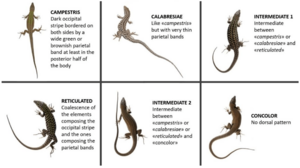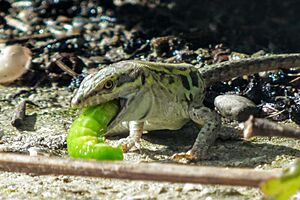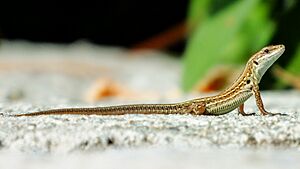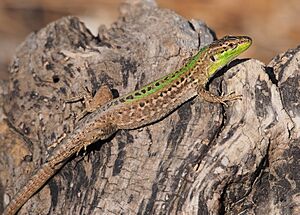Italian wall lizard facts for kids
Quick facts for kids Italian wall lizard |
|
|---|---|
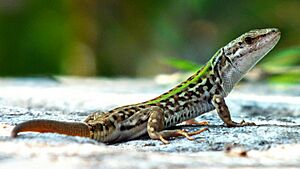 |
|
| An Italian wall lizard near the Entella river in Italy | |
| Conservation status | |
| Scientific classification | |
| Genus: |
Podarcis
|
| Species: |
siculus
|
| Synonyms | |
|
|
The Italian wall lizard or ruin lizard (Podarcis siculus) is a type of lizard from the Lacertidae family. Its name Podarcis siculus comes from Greek words meaning "agile feet." These lizards are originally from southern and southeastern Europe. However, they have also been brought to other parts of Europe and North America. In some places, they are considered an invasive species, meaning they can take over areas and affect native animals.
Italian wall lizards can live in many different places, both natural areas and places changed by humans. They also eat a wide variety of foods. This helps them live in so many different regions.
This lizard species is known for having many different types, called subspecies, across its large home range. Studies show how quickly these subspecies can change and become unique when they are separated from larger groups, like on islands. A study in 2008 even showed how quickly these lizards can evolve with clear changes in their bodies and behaviors.
Italian wall lizards show sexual dimorphism, which means males and females look different. Their exact appearance can vary between subspecies. Generally, they have a green or brown back and a white or green belly. They are also oviparous, meaning the females lay eggs. They usually lay 3 or 4 groups of eggs each year.
Contents
What is a Subspecies?
The Italian wall lizard has many different subspecies. These are like different "versions" of the same animal. Scientists have described dozens of these subspecies. Some are very similar, with only small differences in their looks. For example, some studies have identified over 50 different subspecies!
Sometimes, Italian wall lizards can even breed with other types of Podarcis lizards, like P. tiliguerta. This is called hybridization.
Island Life and Lizard Changes
Because there are so many subspecies and they live in so many places, scientists study Italian wall lizards to understand how animals evolve. One idea they look at is "island effects." This means that animals on islands might change in unique ways because they have new places to live or different foods to eat.
For example, a study looked at Italian wall lizards from 30 islands and 24 mainland areas. They wanted to see if lizards on islands were different in terms of head shape, size, and how much males and females differed. They found that lizards from islands were generally smaller. Also, the size difference between male and female lizards was less noticeable on islands. This is interesting because the "Island Syndrome" idea often suggests that island animals might get bigger. However, it also predicts less difference between sexes, which was seen in these lizards.
Another study looked at how head size, jaw muscles, and bite force changed in different lizard groups. They found that what the lizards ate in their habitat affected how strong their bite was and how big their jaw muscles were. For instance, on islands where food was harder to chew, lizards had stronger bites and muscles. This shows that the environment can really shape how these lizards look and act over time.
Physical Features of the Italian Wall Lizard
The Italian wall lizard typically measures about 150 to 250 mm (6 to 10 inches) from its snout to the base of its tail. As mentioned, their backs are usually green or brown, and their bellies are white or green.
However, their size and colors can vary a lot because of the many subspecies. Some subspecies are "melanic," which means they have hints of blue or black on their backs and bellies. This blue color is usually seen in lizard populations living on islands, not on the mainland.
Male Italian wall lizards have larger heads and stronger jaws than females. Scientists think this difference helps males eat certain prey and also helps them in fights with other males.
Where Do Italian Wall Lizards Live?
True to their name, Italian wall lizards are very common in Italy. Their natural home also includes countries like Bosnia and Herzegovina, Croatia, France, Montenegro, Serbia, Slovenia, and Switzerland.
Lizards in New Places
These lizards have also been introduced to new places. This means they were brought there by humans, sometimes on purpose and sometimes by accident. They can now be found in Spain, Turkey, the United States, and Canada.
In North America, Italian wall lizards have been seen in places like Topeka, Kansas, Long Island, New York, and the Cincinnati area of Ohio. They have become so successful in Cincinnati that the Ohio Department of Natural Resources now considers them a normal resident, not just an invasive species.
Sometimes, people even illegally "trade" these lizards by mail and release them in their own yards. The lizards seem to spread along railroad tracks, helping them move to new areas. They have also arrived in Great Britain by hiding in shipments of grapes.
When Italian wall lizards arrive in new places, they can compete with native lizard species. For example, in Spain, they compete with the native Podarcis virescens lizards. The Italian wall lizards often win, pushing out the native species.
Habitat and Lifestyle
Italian wall lizards are very adaptable and can live in many different environments. You can find them in forests, grasslands, shrublands, rocky areas, and even farmland. They can live in open, sunny places because they are "thermophilic." This means they can handle and even thrive in high temperatures.
What Do Italian Wall Lizards Eat?
Italian wall lizards are "generalist predators." This means they eat a wide variety of foods. Their diet mainly consists of small invertebrates, especially arthropods like insects. They can also eat small vertebrates.
Interestingly, plants make up a larger part of their diet compared to other related lizards. Male lizards tend to have a more varied diet than females. Lizards living on islands often eat more plant matter than those on the mainland.
Who Eats Italian Wall Lizards?
Common predators of the Italian wall lizard include snakes, birds, and feral cats.
Reproduction and Life Cycle
Italian wall lizards are oviparous, meaning the females lay eggs. Females can lay 3 or 4 groups of eggs, called clutches, each year. Each clutch usually has 4 to 7 eggs. The number of eggs can change depending on where the lizards live. For example, lizards on small Croatian islands lay fewer eggs, but those eggs hatch into larger babies.
The breeding season for these lizards usually runs from May to July. Female lizards carrying eggs (called "gravid" females) spend more time basking in the sun. This helps their eggs develop properly.
Diseases and Parasites
Italian wall lizards can get various parasites and bacteria. Some common bacteria include Pantoea, Citrobacter, and E. coli. Some of these bacteria have even been found to be resistant to antibiotics.
Common parasites include pinworms and ticks. Some bacteria and parasites found in mainland lizard populations can be zoonotic, meaning they can spread to humans or other animals.
Tick infestations are common, especially in places changed by humans. Larger male lizards often have more ticks, possibly because they move around more. The number of ticks can also depend on the type of habitat. For instance, females in traditional olive farms have more ticks than those in modern olive farms.
Amazing Rapid Adaptation
In 1971, scientists moved 10 Italian wall lizards (5 male-female pairs) from one Croatian island (Pod Kopište) to another nearby island (Pod Mrčaru). The islands were similar, and there were few predators. The lizards on Pod Mrčaru grew in number, even outcompeting another lizard species that used to live there.
When scientists returned to Pod Mrčaru in the 1990s, they found something amazing. The lizards on Mrčaru looked very different from the original lizards on Kopište! Even though they were genetically very similar, the Mrčaru lizards were larger, had shorter back legs, and couldn't run as fast. They also reacted differently to fake predator attacks. These changes happened because there were fewer predators and more plants to hide in on Mrčaru.
In 2008, more studies showed even bigger changes. The Mrčaru lizards had longer, wider, and taller heads, and a stronger bite force. This was because their diet had changed. The original Kopište lizards mainly ate insects, but the Mrčaru lizards ate a lot more plants.
Another incredible discovery was that the Mrčaru lizards had developed "cecal valves" in their guts. These are like special chambers that help them digest plants by letting tiny organisms break down tough plant material. Cecal valves are very rare in lizards. This was a brand new feature that had evolved in just a few decades! This shows how quickly animals can adapt to new environments.
Behavior
How Italian Wall Lizards Eat
Italian wall lizards prefer to eat prey that isn't brightly colored or obvious. They tend to avoid colorful insects that might be poisonous. If they do try to eat something unpleasant, they might throw their head back and rub their snout on the ground. This behavior suggests they can detect bad chemicals in their prey.
Sometimes, extreme feeding behavior has been seen, including one case of an adult male eating a young lizard.
How Italian Wall Lizards Learn
Italian wall lizards are quite smart and can learn different tasks. For example, they can be taught to remove colored caps from food containers to get a treat.
They can also learn from each other! In one experiment, lizards watched other lizards remove caps from food pods. The lizards who watched were much better at the task than those who didn't. They could even learn from lizards of a different species, though it took a bit longer.
Lizard Fights and Competition
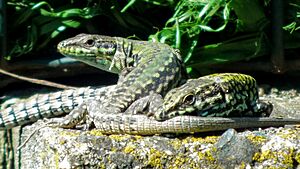
In some groups of Italian wall lizards, many individuals are missing toes. This suggests there's a lot of fighting among them. A study in 2009 on the Croatian island of Pod Mrčaru found that over half the lizards were missing a toe. Males were more likely to have missing toes than females. Lizards with missing toes also had stronger bites. This suggests that fighting, especially among males, is common when there are many lizards in one area.
More aggressive lizards tend to spend more time basking in the sun. This means they can use warm spots for longer periods and grow faster than less aggressive lizards. This social behavior can be established quickly and last a long time.
Avoiding Predators
Italian wall lizards can sense the smell of predators and change their behavior to stay safe. They can even tell the difference between dangerous and harmless snakes by their smell. When they smell a predator, they might flick their tongues more (a sign of stress). They also might run, vibrate their tails, or suddenly start moving.
Tail-waving might distract predators, making them focus on the tail instead of the lizard's body. Sudden, unpredictable movements can make it harder for predators to catch them.
A lizard's anti-predator behavior can also depend on whether a female is carrying eggs. Females with eggs move less and bask less when predators are around. This helps them balance staying safe with keeping their eggs warm.
Lizards from areas with more predators tend to run faster and flee further when threatened. These rapid changes show how quickly Italian wall lizards can adapt to their environment. Their behavior also changes based on their habitat. For example, young lizards from olive tree farms might run towards a tree to escape, while those from vineyards might run short distances and hide.
How Lizards Use Light
Animals can use the way light is polarized (how light waves vibrate) to find their way around. Italian wall lizards can use polarized light to orient themselves. They can learn a direction using white polarized light. They can also orient correctly under blue and cyan light. However, red light seems to confuse them. They also have a "time-compensated celestial compass," which means they can use the sun's position to navigate, even if the sun isn't visible.
How Habitat Affects Behavior
A study in 2005 compared the behavior of Italian wall lizards in New York (where they were introduced) to those in Rome (their native home). The lizards in New York were active for fewer months of the year (April to October) and fewer hours each day. This is likely because New York has colder temperatures than Rome, where lizards are active all year.
Conservation Status
The Italian wall lizard is listed as a species of least concern by the International Union for Conservation of Nature (IUCN). This means their population is healthy and growing.
Pesticides and Lizard Health
Because Italian wall lizards often live in farm areas, scientists worry about how pesticides might affect them. A 2021 study found that lizards on farms using traditional pesticides had more "oxidative stress." This means their bodies were working hard to fight off damage from chemicals. Lizards exposed to pesticides also had more DNA damage.
Female lizards carrying eggs that were exposed to pesticides laid larger, but lower-quality, eggs. However, the baby lizards' ability to move didn't seem to be affected by their mother's pesticide exposure. Also, some common farm pesticides didn't seem to harm the lizards' brains or immune systems.
See also
- List of reptiles of Italy




